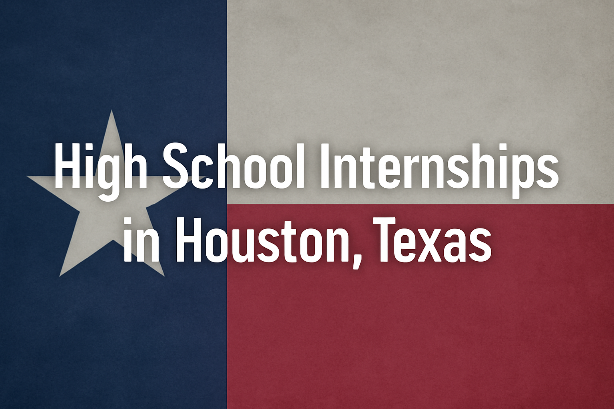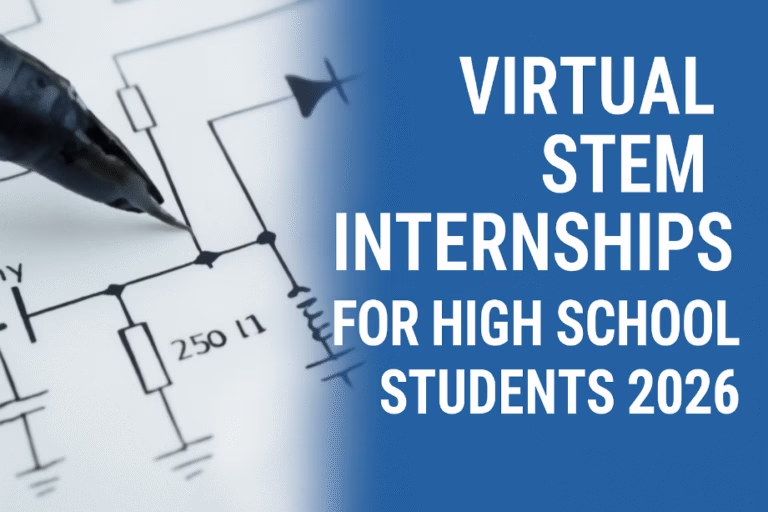15 Best Online Paid Internships for High School Students 2026
Online Paid Internships for High School Students — 2026
Paid online internships give high school students the opportunity to earn while learning — building technical skills, workplace habits, and portfolio deliverables that stand out on college and scholarship applications. This guide lists 15 reputable remote or hybrid programs that regularly offer paid placements or stipends appropriate for ambitious teens (or recent high-school graduates). Each entry links to the official program page and is annotated with eligibility notes so you can quickly determine fit.
How to use this guide
Scan the list and open the official links for programs that match your interests. Note age, citizenship, and school-status restrictions — some platforms (e.g., micro-internship marketplaces) require interns to be 18+ and able to receive payments. For under-18 applicants, focus on opportunities sponsored by universities, research institutes, NGOs, or regional workforce programs that explicitly accept high-school participants.

Top 15 Online / Remote Paid Internship Opportunities (2026)
-
1. Outreachy — Remote, paid open-source internships
Official link: outreachy.org
Description: Outreachy places participants in open-source engineering projects with remote mentorship. Interns work on real OSS codebases and receive a substantial stipend for the 3-month program.
Requirements: Outreachy targets people from groups underrepresented in tech and requires applicants to be 18+; international applicants are accepted. This is an excellent paid remote route for gap-year high school graduates or older teens who meet the eligibility rules.
Paid: Yes — multi-thousand dollar stipend per internship cycle.
Location: Fully remote.
Timeline: Outreachy runs two cohorts per year (winter and summer); check the website for exact application windows.
-
2. Google — Computer Science Summer Institute (CSSI) & select paid scholar tracks
Official link: Google CSSI
Description: Google’s CSSI (for rising college freshmen/high-school seniors) is an intensive program that has online cohorts and provides stipends or covered costs in many cohorts. While CSSI is educational rather than a traditional paid internship, accepted students often receive cost support and strong career exposure.
Requirements: Typically targeted at high-school seniors entering college; check the current year eligibility and cohort format.
Paid/Support: CSSI is offered at no direct cost and often includes stipend/expense coverage for participants. For paid, project-based internships at Google (true work internships) university status is usually required; still, CSSI is a high-value funded experience.
Location: Online and occasional in-person cohorts.
Timeline: Applications typically open in late winter; consult Google’s program pages for exact dates.
-
3. Outreach & Research Internships at J. Craig Venter Institute (JCVI)
Official link: jcvi.org/education
Description: JCVI runs mentored research internships that include wet-lab and bioinformatics options. Their policy favors compensating interns or offering academic credit; some remote/bioinformatics tracks are suitable for virtual placement.
Requirements: Varies by program; some tracks accept high-school students (often with parental/work-permit paperwork for minors).
Paid: JCVI states interns are compensated monetarily and/or by earning school credit for many programs. Check the specific offering for stipend details.
Location: Hybrid (remote bioinformatics options exist) or on-site depending on the project.
Timeline: Annually posted — review education pages in winter/spring for summer cycles.
-
4. Fred Hutch — Summer High School Internship Program (SHIP)
Official link: FredHutch SHIP
Description: Fred Hutch’s SHIP is a competitive, paid summer research internship for high-school juniors and seniors. While it is largely on-site, Fred Hutch has expanded remote/hybrid options in some cycles and offers strong stipend support.
Requirements: High-school junior or senior; selection is competitive.
Paid: Yes — SHIP is a paid full-time summer program.
Location: Seattle (hybrid/remote options may occur—check the program page).
Timeline: Application windows typically run in winter for summer placement.
-
5. St. Jude Children’s Research Hospital — High-School Research Internships (selected tracks)
Official link: stjude.org/internships
Description: St. Jude runs high-school research immersion programs (e.g., POE) and certain information-services internships that provide stipends; some roles include remote/virtual components.
Requirements: Program-specific; many require applicants to be high-school seniors or recent graduates and meet age rules.
Paid: Select St. Jude internships include stipends for accepted participants.
Location: Memphis (some remote prep or hybrid tasks may be available).
Timeline: Deadlines typically fall in winter — check St. Jude’s education pages for specifics.
-
6. Genesys Works — Paid Tech & Business Internships (remote options vary by chapter)
Official link: genesysworks.org
Description: Genesys Works places high-school students in paid internships with corporate partners (IT, operations, analytics). Many chapters offer remote or hybrid placements when employer partners permit remote work.
Requirements: High-school juniors/seniors from participating regions; selection includes training and placement readiness.
Paid: Yes — Genesys Works placements are paid.
Location: U.S. local chapters (remote/hybrid availability depends on employer).
Timeline: Apply via your local chapter in winter/spring for summer placements.
-
7. Virtual Internships — Placement service with paid host options
Official link: virtualinternships.com
Description: Virtual Internships is a placement platform that matches students with remote roles (marketing, data, research). Some host companies pay interns directly; others are fee-based placements — always confirm payment on the individual placement page.
Requirements: Varies by placement; some roles accept motivated high-school students or recent grads.
Paid: Mixed — some placements are employer-paid. Check each posting for the payment model.
Location: Remote.
Timeline: Rolling applications; apply at least 4–6 weeks before your desired start date.
-
8. Parker Dewey / Micro-internships — Paid short projects (NOTE: 18+)
Official link: parkerdewey.com
Description: Parker Dewey posts paid short-term, real work projects (market research, data entry, analysis). These micro-internships are an effective way to earn while building a portfolio — but the platform requires contractors to be 18+ and able to accept payments.
Requirements: Must be 18+; payment receipt (SSN/ITIN) often required for U.S. projects — good for older teens and gap-year students.
Paid: Yes — per project compensation.
Location: Remote.
Timeline: Projects posted year-round; summer months see high volume.
-
9. Palantir — Meritocracy Fellowship (recent high-school grads)
Official link: Palantir Student Programs
Description: Palantir’s Meritocracy Fellowship is a paid, several-month program for top high-school graduates as an alternative to college (announced in 2025). It’s highly selective and pays well — a real (paid) pathway for high-achieving grads seeking industry apprenticeship rather than immediate college enrollment.
Requirements: Merit-based criteria (e.g., very high standardized scores or equivalent demonstrated achievement); aimed at recent high-school graduates rather than current underclassmen.
Paid: Yes — high monthly stipend reported in the announcement. Check Palantir’s student pages for the 2026 cycle.
Location: Roles may be remote or hybrid depending on placement.
Timeline: Announcements and application windows are published on Palantir’s student careers pages.
-
10. Veritas AI — Cohort internships and paid scholar pathways
Official link: veritasai.com
Description: Veritas AI runs AI/ML pathway programs and project internships for high-school learners. Selected cohorts include paid scholar roles or funded scholarships in partnership with research sponsors.
Requirements: Programming or data-project experience recommended; cohorts often screen by short application and project sample.
Paid: Some cohorts provide stipends or paid scholar status; check current cohort details. :contentReference[oaicite:10]{index=10}
Location: Remote.
Timeline: Rolling cohort starts; summer offerings fill early.
-
11. NASA Internships — paid stipends for many students (virtual & remote tracks)
Official link: nasa.gov/internships
Description: NASA runs a broad family of student programs; many intern tracks provide paid stipends based on academic level and session length. While most NASA intern roles are targeted to college students, NASA offers high-school–oriented remote programs (e.g., GeneLab for High Schools) and stipended research opportunities in some centers.
Requirements: Vary by program — certain high-school tracks require U.S. citizenship/PR and minimum grade thresholds.
Paid: Many NASA interns receive stipend awards; verify per program.
Location: Remote and on-site opportunities depending on center and track.
Timeline: Application windows vary by program (winter/spring for summer placements).
-
12. MD Anderson / Major Cancer Centers — selected paid summer research internships
Official link (example): MD Anderson Education & Training
Description: Several major medical and research centers (MD Anderson, St. Jude, NCI affiliates) run paid high-school research internships or summer programs that may include remote data projects or hybrid lab rotations with stipends for accepted participants.
Requirements: Program dependent; many require applicants to be 16–18 or recent graduates.
Paid: Many cancer-center high-school research programs provide stipends. See individual program pages for amounts.
Location: Hybrid/remote options sometimes available.
Timeline: Applications often close in January–March for summer cohorts.
-
13. Intern Abroad HQ / InternHQ — Remote & virtual paid host opportunities
Official link: internhq.com
Description: Intern Abroad HQ lists internships (including remote business/NGO placements) and sometimes advertises positions with host companies that will pay stipends. Their listings are curated and include detailed host information.
Requirements: Varies by placement; many high-school or gap-year programs exist.
Paid: Mixed — some hosts provide stipends; check listing details.
Location: Remote or hybrid.
Timeline: Rolling; check summer availability early.
-
14. Ladder Internships — cohort remote projects (startup & business)
Official link: ladderinternships.com
Description: Ladder runs cohort-based remote internships where teens build product features or business analyses with mentor feedback. Some cohorts are paid or provide stipends; others are low-cost with outcome guarantees.
Requirements: High-school students and gap-year participants; portfolio preferred.
Paid: Some cohorts offer pay or stipends; verify per cohort.
Location: Remote.
Timeline: Multiple cohorts year-round, with summer intensives.
-
15. Self-Directed Remote Paid Projects (small businesses & micro-contracts)
Approach: If formal program rules exclude minors, older teens can create a short paid remote internship by pitching a defined project (market research, social-media campaign, data clean-up) to a local small business or nonprofit. This is often the fastest path to paid remote work if you can demonstrate a deliverable and agree payment in writing.
Requirements: Initiative, clear deliverables, parental consent and an ability to receive payment (if required by host jurisdiction).
Paid: Negotiable — many small businesses will offer modest pay for clear, short deliverables.
Location: Remote.
Timeline: Quick to set up (2–6 weeks) — great for students under 18 who need flexible arrangements.

Why reputable programs matter
Choose programs run by universities, global NGOs, medical research centers, or well-known platforms — they provide vetted mentors, clearer payment policies, and better references. Programs listed above (Outreachy, Google CSSI, Genesys Works, Palantir’s announced fellowship, JCVI, St. Jude, Fred Hutch, NASA, etc.) are established names that provide meaningful outcomes and documented support structures. When in doubt, ask the program coordinator about payment method, mentor ratio, and past student outcomes.
Application strategy — proven checklist
- Pick 3 target programs from this list that align with your goals (technical, research, business).
- Prepare a short portfolio: 1–3 projects (GitHub link, research summary PDF, or a one-page marketing case study).
- Craft a focused personal statement (200–400 words): explain what you want to build, what you’ll deliver, and how the mentor should measure success.
- Ask for references early: one STEM teacher and one coach/mentor who can comment on your reliability and curiosity.
- Confirm payment logistics: If accepted, get payment terms in writing (amount, schedule, method). For minors, discuss parental consent & payment routing ahead of time.
Sample outreach email (for self-directed paid projects)
Subject: Remote Market-Research Pilot — 3-week Proposal (Paid) Hello [Name], I’m [Your Name], a high-school junior interested in market research and digital growth. I’d like to propose a short remote project to support [Company]: a 3-week competitor analysis and customer persona report focused on [product area]. Deliverables: a 6-page report, 10-slide summary, and an implementation checklist. I can start on [date], commit [x] hours/week, and request a modest stipend of [$X] for the completed deliverable. Happy to do a 2-hour unpaid trial or provide references. Would you be open to a 10-minute call? Thanks, [Your Name] — [email] — [phone]
Payments, taxes & minors — practical notes
- Receiving payment: U.S. platforms typically require an SSN/ITIN for payroll. If you don’t have one, ask programs whether they can pay via scholarship, grant, or school partnership instead.
- Parental consent: Minors often need parental consent or a work permit depending on local laws; clarify this before signing any contract.
- Tax treatment: Small stipends may still be taxable — keep records and ask your parent/guardian to consult a tax advisor if needed.
Related posts
For more options and targeted lists see our other guides: Paid Remote Internships for High School Students 2026, Virtual STEM Internships for High School Students 2026, Online Paid Internships for High School Students 2026, Paid Internships Abroad for High School Students 2026, and Remote Summer Internships for High School Students 2026.
Frequently Asked Questions (FAQs)
1. Are there many paid online internships for high-schoolers?
There are fewer than for university students, but high-quality paid remote options exist (open-source fellowships like Outreachy, cohort scholar tracks, university research stipends, and micro-projects for older teens). For younger students, hybrid paid research programs and local paid placements (Genesys Works, major cancer-center programs, Fred Hutch SHIP) are reliable. Always confirm age eligibility and payment terms on the official pages.
2. If a platform says “paid,” how do I verify it’s real?
Check (A) the official host page (not only an aggregator), (B) past participant testimonials, (C) transparent stipend amounts and payment schedule, and (D) whether payment will be sent directly by the host or via a third-party vendor. If any org asks you to pay to get paid, treat that as a red flag.
3. Can I do multiple short paid micro-internships over one summer?
Yes — micro-internships and short paid projects are designed to be stacked (so long as you manage time and avoid conflicts). Parker Dewey and similar platforms list numerous short remote tasks during summer months (note: Parker Dewey requires interns to be 18+).
4. Are remote paid internships credible on college applications?
Absolutely. Colleges value real work and measurable outcomes. A paid micro-internship, a published open-source contribution from Outreachy, or a Fred Hutch stipended research project are strong evidence of initiative and impact.
5. What if I’m under 18 and a site requires 18+?
Options include: (A) focus on university-sponsored/high-school-friendly paid programs (Genesys Works, research center internships), (B) pursue self-directed paid projects with local businesses (with parental consent), or (C) prepare for 18+ micro-internship platforms by building a portfolio now and applying when eligible.
Final tips
- Apply early — many paid programs announce windows in winter and close by late spring.
- Prioritize deliverables — employers prefer candidates who can show what they’ll produce (report, code, dashboard).
- Keep communications professional — even at high school level: timely emails, short agendas for calls, and confirmed payment terms protect you.










3 Comments